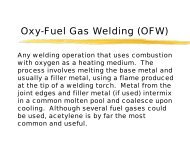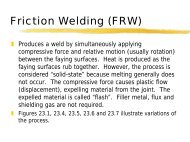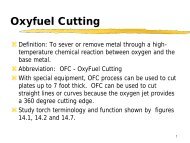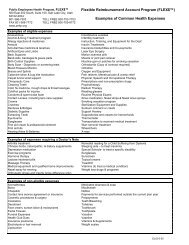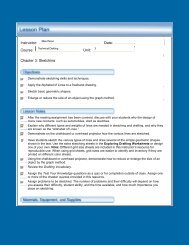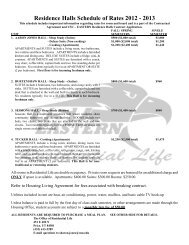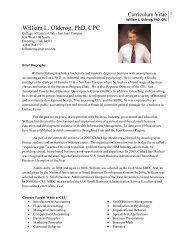Lesson Plan
Lesson Plan
Lesson Plan
You also want an ePaper? Increase the reach of your titles
YUMPU automatically turns print PDFs into web optimized ePapers that Google loves.
Instructor:<br />
Course:<br />
Elias Perez<br />
Technical Drafting<br />
Chapter 10: Dimensioning<br />
Unit: 10<br />
Date:<br />
Explain why dimensions and notes are needed on drawings.<br />
Identify, explain, and accurately use the two systems of linear measurement to<br />
dimension drawings.<br />
Describe the difference between unidirectional and aligned dimensioning.<br />
Identify and explain the three basic types of dimensions.<br />
Apply the general rules for dimensioning inch and/or metric drawings.<br />
Dimension circles, holes, arcs, and angles.<br />
Explain the methods used in the conversion to metric dimensioning from<br />
conventional inch dimensioning.<br />
Describe the basic principles of geometric dimensioning and tolerancing.<br />
Explain how dimensions are generated in computer-aided drafting.<br />
After students have read the chapter, review it with them. Discuss the following:<br />
The reasons a drawing must be dimensioned accurately.<br />
The reasons notes are needed on a drawing.<br />
Aligned and unidirectional dimensioning.<br />
General rules for dimensioning.<br />
The problems that might occur if an improperly dimensioned drawing is<br />
used to manufacture an object.<br />
The proper way to dimension circles, holes, and arcs. Refer to old and new<br />
ASME standards.<br />
The proper way to dimension angles.<br />
Project a drawing that is improperly dimensioned with a jumble of lines and<br />
dimensions. Project the same drawing properly dimensioned.
If time permits, discuss the changeover from conventional measurement to metric<br />
measurement and the problems that can occur if not done properly.<br />
Review the Drafting Vocabulary.<br />
Assign the Test Your Knowledge questions as a quiz or for completion outside of<br />
class . Assign either of the chapter quizzes provided in this resource.<br />
Assign the problems at the end of the chapter. The number of problems assigned<br />
and their difficulty will depend on the time available and student ability. To save<br />
time and increase the number of problems that can be done, use the preprinted<br />
sheets in the Exploring Drafting Worksheets.<br />
Have students volunteer for Outside Activities assignments.<br />
Materials: Drafting Textbook<br />
Drafting tools<br />
Drafting media<br />
1. Contact several industrial drafting departments. If possible, obtain copies of the standards they<br />
use for dimensioning. Compare how similar or dissimilar they are. Do they vary by industry?<br />
2. Obtain copies of several industrial prints. Study how they are dimensioned and how notes are<br />
used. Are there any provisions for foreign components to be used with the items on the prints? Will<br />
the parts be exported?<br />
Worksheet 10-1: Dimensioning Problems<br />
Worksheet 10-2: Dimensioning Problems<br />
Worksheet 10-3: Dimensioning Problems<br />
Worksheet 10-4: Dimensioning Problems<br />
Worksheet 10-5: Dimensioning Problems<br />
Worksheet 10-6: Dimensioning Problems<br />
Reproducible Master 10-1: Dimensioning Methods<br />
Reproducible Master 10-2: Dimensioning Lines and Standards
Reproducible Master 10-3: Preferred Dimensioning Practices (Grouping and<br />
Placement)<br />
Reproducible Master 10-4: Preferred Dimensioning Practices (Object Description<br />
and Extension Lines)<br />
Reproducible Master 10-5: Metric Dimensioning Methods<br />
Transparency 10-1: Dimensioning Hole Features<br />
Other resource:<br />
Other resource:<br />
1. Test Your Knowledge Questions, Text page 246<br />
2. Quiz 10A, Instructor's Resource CD<br />
3. Quiz 10B, Instructor's Resource CD<br />
4. Other assessment:<br />
American Society of Mechanical Engineers (ASME)<br />
www.asme.org





